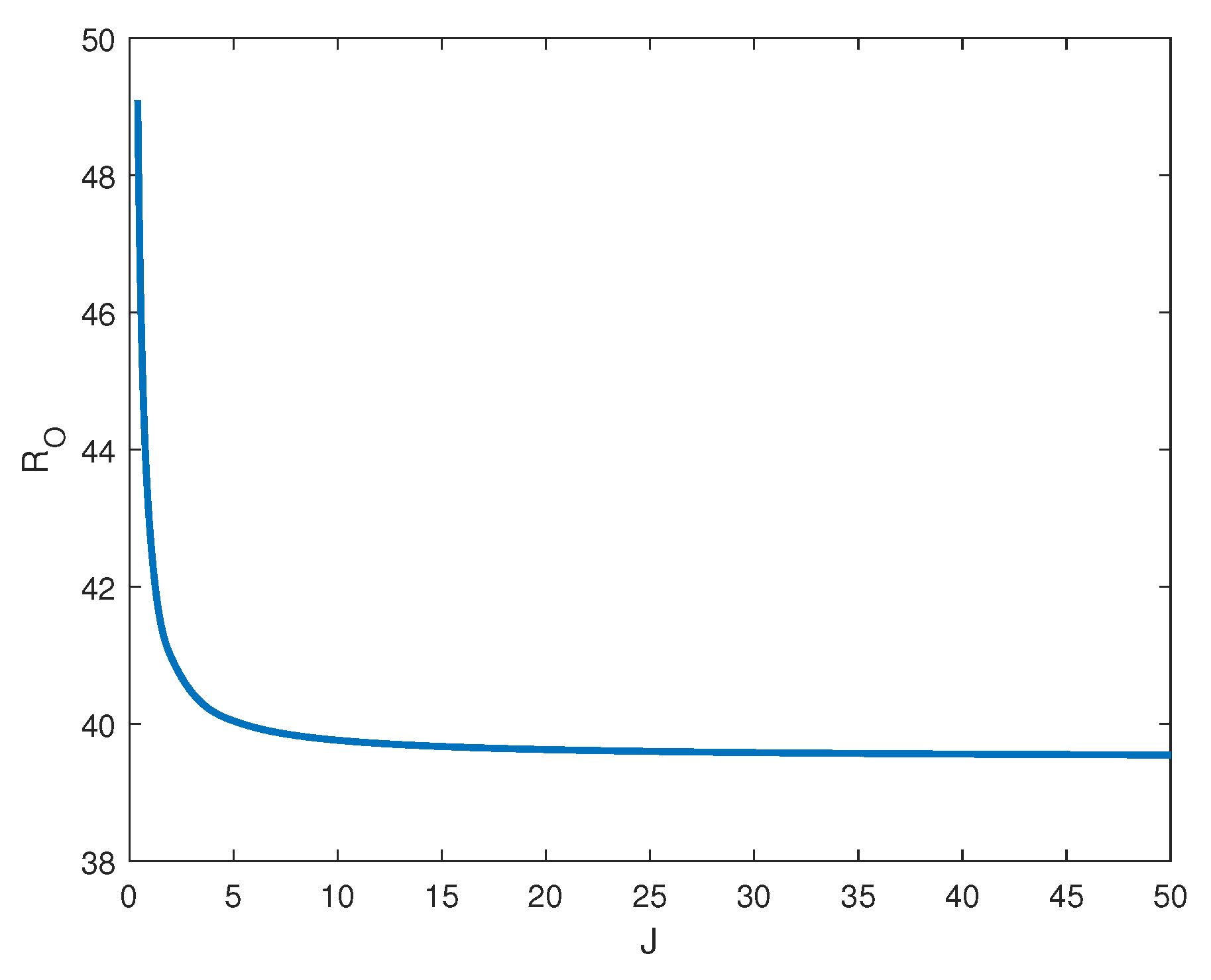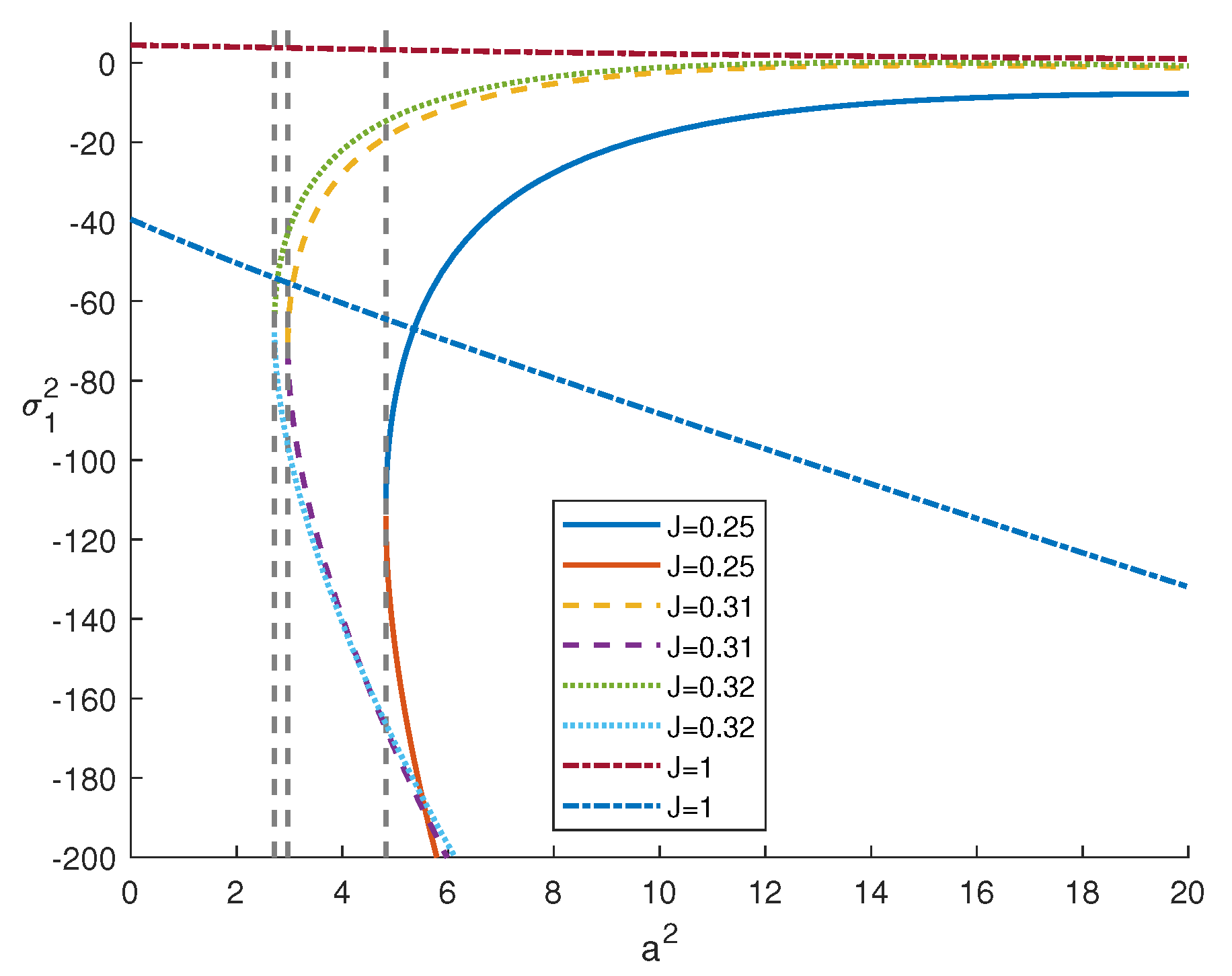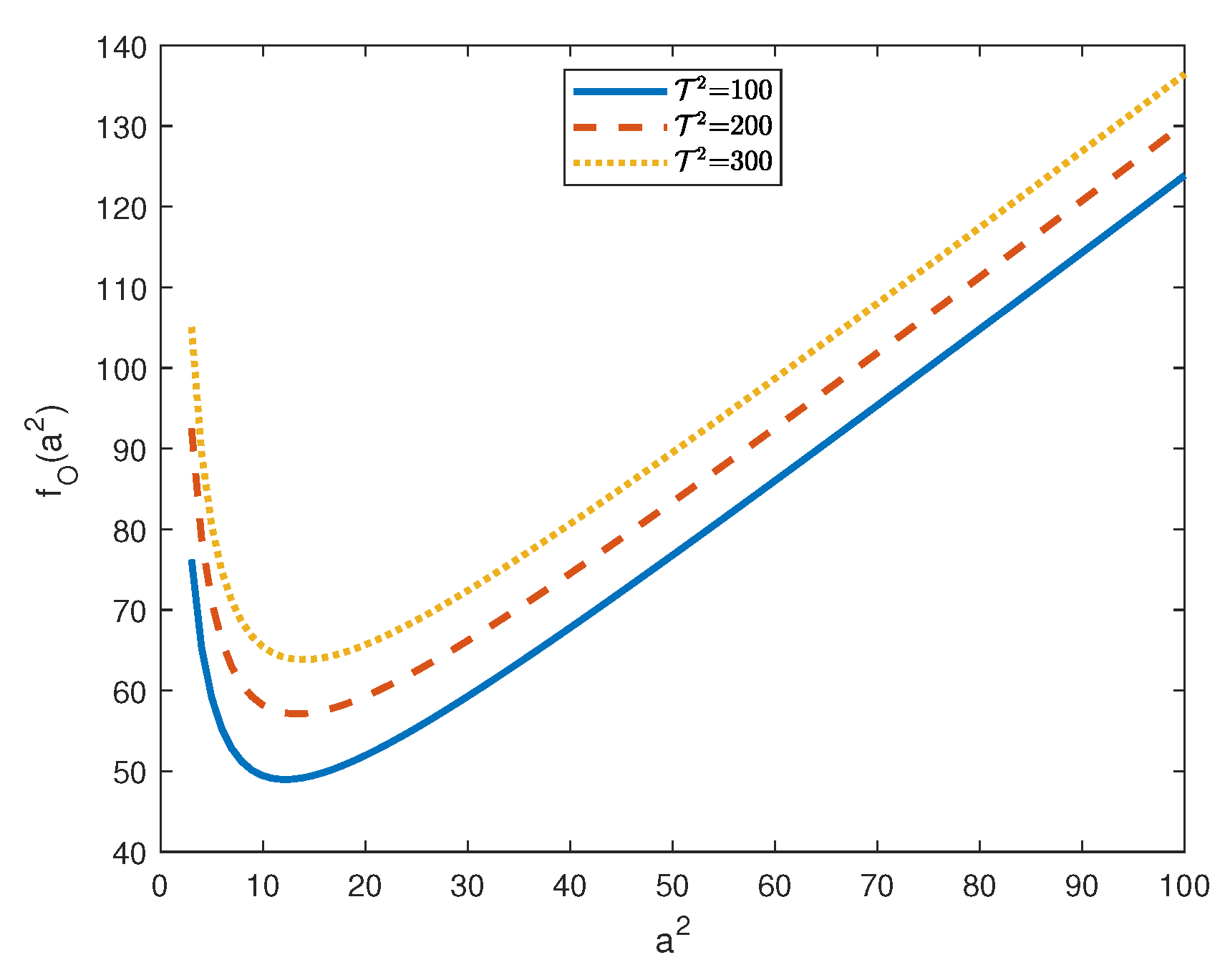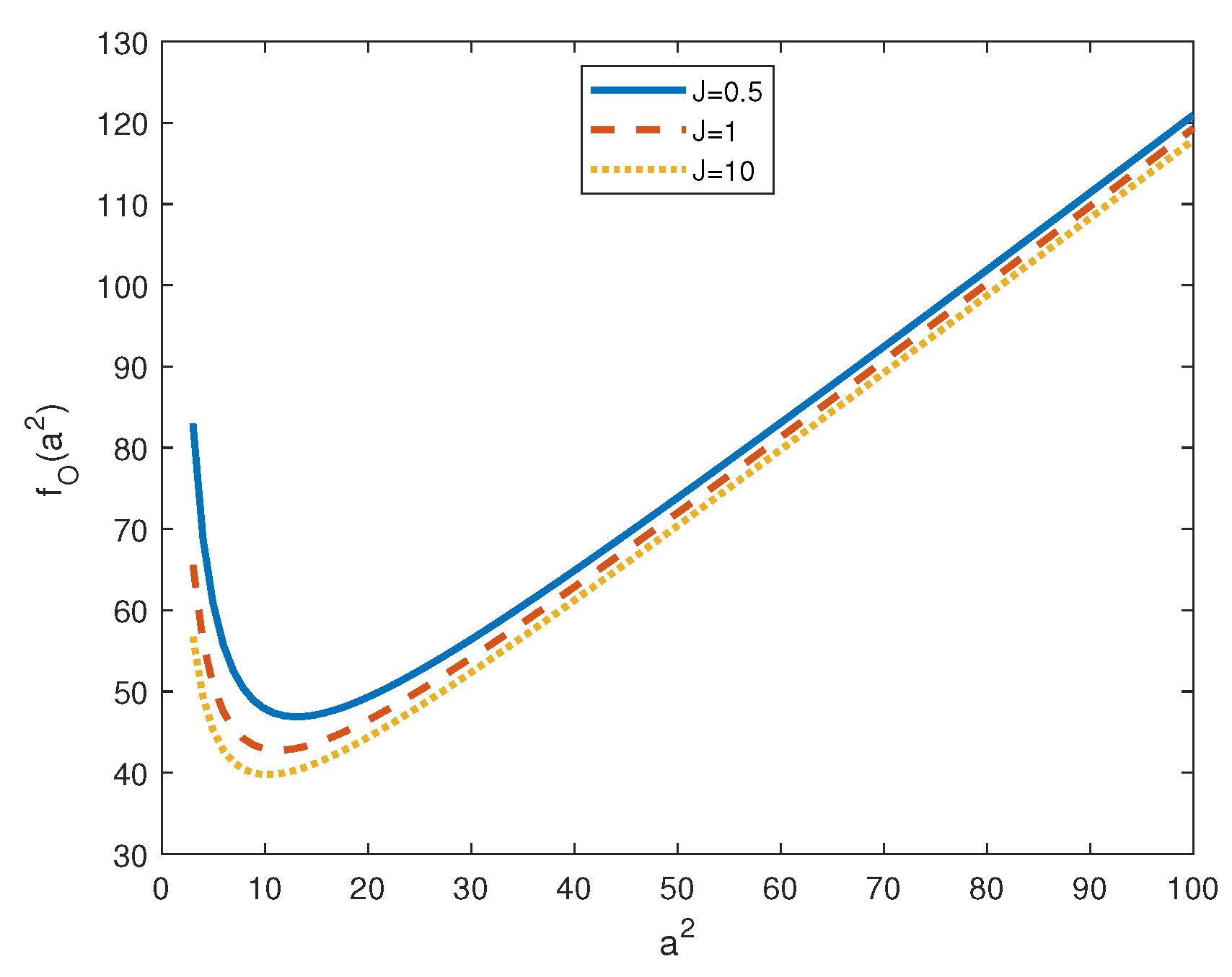The Effect of the Vadasz Number on the Onset of Thermal Convection in Rotating Bidispersive Porous Media
Abstract
:1. Introduction
2. Preliminaries
3. Linear Instability
3.1. Steady Convection
3.2. Oscillatory Convection
4. Numerical Results
- (1)
- analyze the asymptotic behaviour of with respect to and J; and,
- (2)
- compare and to establish whether the convection arises through a steady state (stationary convection) or via an oscillatory state (oscillatory convection).
- (i)
- if or if , then convection can only arise via a steady state;
- (ii)
- if , convection can only arise via an oscillatory state.
5. Conclusions
- does not depend on the acceleration coefficient, i.e., inertial effects do not affect ;
- increases with the Taylor number, i.e., has—as one is expected—a stabilizing effect on the onset of steady convection; and,
- is a decreasing function of J and there exists a threshold for the inertia coefficient, such that exists and convection arises via an oscillatory state; and,
- is an increasing functions of and there exists a threshold for the Taylor number, such that, for , the convection arises via an oscillatory state.
Author Contributions
Funding
Acknowledgments
Conflicts of Interest
References
- Capone, F.; Gentile, M.; Hill, A.A. Convection problems in anisotropic porous media with nonhomogeneous porosity and thermal diffusivity. Acta Appl. Math. 2012, 122, 85–91. [Google Scholar] [CrossRef]
- Capone, F.; Rionero, S. Porous MHD convection: Stabilizing effect of magnetic field and bifurcation analysis. Ricerche Mat. 2016, 65, 163–186. [Google Scholar] [CrossRef]
- Straughan, B. Stability and Wave Motion in Porous Media. Applied Mathematical Sciences; Springer: Berlin, Germany, 2008; Volume 165. [Google Scholar]
- Chen, Z.Q.; Cheng, P.; Hsu, C.T. A theoretical and experimental study on stagnant thermal conductivity of bi-dispersed porous media. Int. Commun. Heat Mass Tranf. 2000, 27, 601–610. [Google Scholar] [CrossRef]
- Chen, Z.Q.; Cheng, P.; Zhao, T.S. An experimental study of two phase flow and boiling heat transfer in bi-disperse porous channels. Int. Commun. Heat Mass Transf. 2000, 27, 293–302. [Google Scholar] [CrossRef]
- Nield, D.A.; Kuznetsov, A.V. The onset of convection in a bidisperse porous medium. Int. J. Heat Mass Transf. 2006, 49, 3068–3074. [Google Scholar] [CrossRef]
- Lin, F.C.; Liu, B.H.; Huang, C.T.; Chen, Y.M. Evaporative heat transfer model of a loop heat pipe with bidisperse wick structure. Int. J. Heat Mass Transf. 2011, 54, 4621–4629. [Google Scholar] [CrossRef]
- Borja, R.L.; Liu, X.; White, J.A. Multiphysics hillslope processes triggering landslides. Acta Geotech. 2012, 7, 261–269. [Google Scholar] [CrossRef]
- Straughan, B. Convection with Local Thermal Non-Equilibrium and Microfluidic Effects. In Advances in Mechanics and Mathematics; Springer: Cham, Switzerland, 2015; Volume 32. [Google Scholar]
- Straughan, B. Effect of inertia on double diffusive bidispersive convection. Int. J. Heat Mass Trasnf. 2019, 129, 389–396. [Google Scholar] [CrossRef] [Green Version]
- Nield, D.A.; Bejan, A. Convection in Porous Media, 5th ed.; Springer: Cham, Switzerland, 2017. [Google Scholar]
- Rees, D.A.S. The effect of inertia on free convection from a horizontal surface embedded in a porous medium. Int. J. Heat Mass Trasnf. 1996, 39, 3425–3430. [Google Scholar] [CrossRef]
- Rees, D.A.S. The effect of inertia on the onset of mixed convection in a porous layer heated from below. Int. Comm. Heat Mass Transf. 1997, 24, 277–283. [Google Scholar] [CrossRef]
- Rabbani, S.; Abderrahmane, H.; Sassi, M. Inertial Effects on Dynamics of Immiscible Viscous Fingering in Homogenous Porous Media. Fluids 2019, 4, 79. [Google Scholar] [CrossRef] [Green Version]
- Capone, F.; De Luca, R. Porous MHD convection: Effect of Vadasz inertia term. Transp. Porous Med. 2017, 118, 519–536. [Google Scholar] [CrossRef] [Green Version]
- Capone, F.; De Luca, R.; Vitiello, M. Double-diffusive Soret convection phenomenon in porous media: Effect of Vadasz inertia term. Ricerche Mat. 2019, 68, 581–595. [Google Scholar] [CrossRef]
- Capone, F.; Rionero, S. Inertia effect on the onset of convection in rotating porous layers via the “auxiliary system method”. Int. J. Non-Linear Mech. 2013, 57, 193–200. [Google Scholar] [CrossRef]
- Vadasz, P. Coriolis effect on gravity-driven convection in a rotating porous layer heated from below. J. Fluid Mech. 1998, 376, 351–375. [Google Scholar] [CrossRef]
- Dogdson, E.; Rees, D.A.S. The onset of Prandtl-Darcy-Prats convection in a horizontal porous layer. Transp. Porous Med. 2013, 99, 175–189. [Google Scholar]
- Capone, F.; Gentile, M. Sharp stability results in LTNE rotating anisotropic porous layer. Int. J. Therm. Sci. 2019, 134, 661–664. [Google Scholar] [CrossRef]
- De Luca, R.; Rionero, S. Steady and oscillatory convection in rotating fluid layers heated and salted from below. Int. J. Non-Linear Mech. 2016, 78, 121–130. [Google Scholar] [CrossRef]
- Capone, F.; De Luca, R. On the stability-instability of vertical throughflows in double diffusive mixtures saturating rotating porous layers with large pores. Ric. Mat. 2014, 63, 119–148. [Google Scholar] [CrossRef]
- De Luca, R.; Rionero, S. Dynamic of rotating fluid layers: L2-absorbing sets and onset of convection. Acta Mech. 2017, 228, 4025–4037. [Google Scholar] [CrossRef] [Green Version]
- Vadasz, P. Fluid Flow and Heat Transfer in Rotating Porous Media; Springer Briefs in Thermal Engineering and Applied Science (eBook); Springer International Publishing: New York, NY, USA, 2016. [Google Scholar]
- Vadasz, P. Instability and convection in rotating porous media: A review. Fluids 2019, 4, 147. [Google Scholar] [CrossRef] [Green Version]
- Falsaperla, P.; Mulone, G.; Straughan, B. Inertia effects on rotating porous convection. Int. J. Heat Mass Transf. 2011, 54, 1352–1359. [Google Scholar] [CrossRef]
- Capone, R.F.; De Luca, M. Gentile, Coriolis effect on thermal convection in a rotating bidispersive porous layer. Proc. R. Soc. Lond. A 2020. [Google Scholar] [CrossRef] [Green Version]
- Falsaperla, P.; Mulone, G.; Straughan, B. Bidispersive inclined convection. Proc. R. Soc. A 2016, 472, 20160480. [Google Scholar] [CrossRef] [PubMed] [Green Version]








| J | ||
|---|---|---|
| 0 | ∄ | ∄ |
| 0.25 | ∄ | ∄ |
| 0.31 | ∄ | ∄ |
| 0.32 | 15.3410 | 51.9150 |
| 0.35 | 14.7812 | 59.7010 |
| 0.4 | 14.0459 | 49.0951 |
| 0.7 | 11.9923 | 44.4657 |
| 1 | 11.2881 | 42.7649 |
| 5 | 10.3196 | 40.0417 |
| 10 | 10.2433 | 39.7591 |
| 7 | 15.3031 | ∄ | 45.5293 | ∄ |
| 7.07 | 15.3234 | 12.5623 | 45.6906 | 46.0730 |
| 7.1 | 15.3320 | 12.5674 | 45.7596 | 46.0815 |
| 7.2 | 15.3603 | 12.5844 | 45.9885 | 46.1098 |
| 7.26 | 15.3769 | 12.5946 | 46.1253 | 46.1268 |
| 7.27 | 15.2796 | 12.5963 | 46.1480 | 46.1296 |
| 7.3 | 15.3878 | 12.6014 | 46.2162 | 46.1381 |
| 7.5 | 15.4410 | 12.6353 | 46.6677 | 46.1945 |
| 10 | 15.919 | 13.0503 | 51.9256 | 46.8876 |
| 20 | 16.1538 | 14.5717 | 67.9956 | 49.4695 |
| 50 | 15.2776 | 18.2109 | 95.5668 | 55.9909 |
| J | CONVECTION | ||||||||
|---|---|---|---|---|---|---|---|---|---|
| 10 | 7 | 2 | 30 | 1.3 | 22.74 | 15.78 | 198.64 | 202.89 | STEADY |
| 10 | 7 | 2 | 100 | 1.3 | 37.07 | 21.08 | 437.66 | 289.54 | OSCILLATORY |
| 0.8 | 1.5 | 0.2 | 300 | 10 | 19.25 | 13.92 | 193.25 | 63.84 | OSCILLATORY |
| 0.8 | 0.5 | 0.2 | 100 | 1 | 21.27 | ∄ | 120.07 | ∄ | STEADY |
| 0.8 | 0.5 | 0.2 | 100 | 1.5 | 21.27 | 17.10 | 120.07 | 44.72 | OSCILLATORY |
© 2020 by the authors. Licensee MDPI, Basel, Switzerland. This article is an open access article distributed under the terms and conditions of the Creative Commons Attribution (CC BY) license (http://creativecommons.org/licenses/by/4.0/).
Share and Cite
Capone, F.; De Luca, R. The Effect of the Vadasz Number on the Onset of Thermal Convection in Rotating Bidispersive Porous Media. Fluids 2020, 5, 173. https://doi.org/10.3390/fluids5040173
Capone F, De Luca R. The Effect of the Vadasz Number on the Onset of Thermal Convection in Rotating Bidispersive Porous Media. Fluids. 2020; 5(4):173. https://doi.org/10.3390/fluids5040173
Chicago/Turabian StyleCapone, Florinda, and Roberta De Luca. 2020. "The Effect of the Vadasz Number on the Onset of Thermal Convection in Rotating Bidispersive Porous Media" Fluids 5, no. 4: 173. https://doi.org/10.3390/fluids5040173
APA StyleCapone, F., & De Luca, R. (2020). The Effect of the Vadasz Number on the Onset of Thermal Convection in Rotating Bidispersive Porous Media. Fluids, 5(4), 173. https://doi.org/10.3390/fluids5040173






